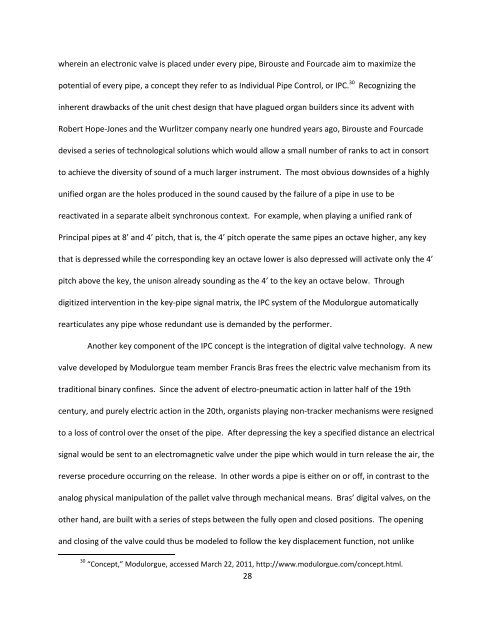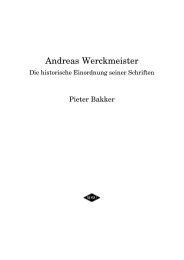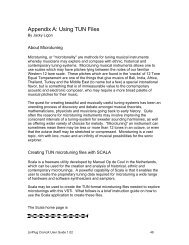Recent Organ Design Innovations and the 21st-century - Stichting ...
Recent Organ Design Innovations and the 21st-century - Stichting ...
Recent Organ Design Innovations and the 21st-century - Stichting ...
Create successful ePaper yourself
Turn your PDF publications into a flip-book with our unique Google optimized e-Paper software.
wherein an electronic valve is placed under every pipe, Birouste <strong>and</strong> Fourcade aim to maximize <strong>the</strong><br />
potential of every pipe, a concept <strong>the</strong>y refer to as Individual Pipe Control, or IPC. 30 Recognizing <strong>the</strong><br />
inherent drawbacks of <strong>the</strong> unit chest design that have plagued organ builders since its advent with<br />
Robert Hope-Jones <strong>and</strong> <strong>the</strong> Wurlitzer company nearly one hundred years ago, Birouste <strong>and</strong> Fourcade<br />
devised a series of technological solutions which would allow a small number of ranks to act in consort<br />
to achieve <strong>the</strong> diversity of sound of a much larger instrument. The most obvious downsides of a highly<br />
unified organ are <strong>the</strong> holes produced in <strong>the</strong> sound caused by <strong>the</strong> failure of a pipe in use to be<br />
reactivated in a separate albeit synchronous context. For example, when playing a unified rank of<br />
Principal pipes at 8’ <strong>and</strong> 4’ pitch, that is, <strong>the</strong> 4’ pitch operate <strong>the</strong> same pipes an octave higher, any key<br />
that is depressed while <strong>the</strong> corresponding key an octave lower is also depressed will activate only <strong>the</strong> 4’<br />
pitch above <strong>the</strong> key, <strong>the</strong> unison already sounding as <strong>the</strong> 4’ to <strong>the</strong> key an octave below. Through<br />
digitized intervention in <strong>the</strong> key-pipe signal matrix, <strong>the</strong> IPC system of <strong>the</strong> Modulorgue automatically<br />
rearticulates any pipe whose redundant use is dem<strong>and</strong>ed by <strong>the</strong> performer.<br />
Ano<strong>the</strong>r key component of <strong>the</strong> IPC concept is <strong>the</strong> integration of digital valve technology. A new<br />
valve developed by Modulorgue team member Francis Bras frees <strong>the</strong> electric valve mechanism from its<br />
traditional binary confines. Since <strong>the</strong> advent of electro-pneumatic action in latter half of <strong>the</strong> 19th<br />
<strong>century</strong>, <strong>and</strong> purely electric action in <strong>the</strong> 20th, organists playing non-tracker mechanisms were resigned<br />
to a loss of control over <strong>the</strong> onset of <strong>the</strong> pipe. After depressing <strong>the</strong> key a specified distance an electrical<br />
signal would be sent to an electromagnetic valve under <strong>the</strong> pipe which would in turn release <strong>the</strong> air, <strong>the</strong><br />
reverse procedure occurring on <strong>the</strong> release. In o<strong>the</strong>r words a pipe is ei<strong>the</strong>r on or off, in contrast to <strong>the</strong><br />
analog physical manipulation of <strong>the</strong> pallet valve through mechanical means. Bras’ digital valves, on <strong>the</strong><br />
o<strong>the</strong>r h<strong>and</strong>, are built with a series of steps between <strong>the</strong> fully open <strong>and</strong> closed positions. The opening<br />
<strong>and</strong> closing of <strong>the</strong> valve could thus be modeled to follow <strong>the</strong> key displacement function, not unlike<br />
30 “Concept,” Modulorgue, accessed March 22, 2011, http://www.modulorgue.com/concept.html.<br />
28











